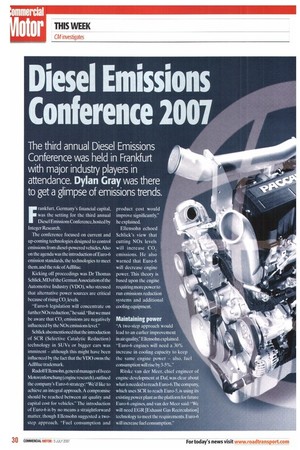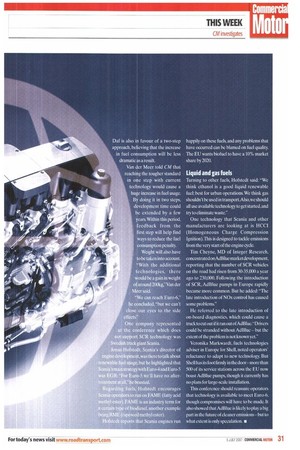F rankfurt, Germany's financial capital, was the setting for the third annual Diesel Emissions Conference, hosted by Integer Research.
Page 32

Page 33

If you've noticed an error in this article please click here to report it so we can fix it.
The conference focused on current and up-coming technologies designed to control emissions from diesel-powered vehicles, Also on the agenda was the introduction of Euro-6 emission standards, the technologies to meet them, and the role of AdBlue.
Kicking off proceedings was Dr Thomas Schlick,MD of the German Association of the Automotive Industry (VDO), who stressed that alternative power sources are critical because of rising CO, levels.
-Euro-6 legislation will concentrate on further NOx reduction," he said."But we must be aware that CO, emissions are negatively influenced by the NOx emissions level."
Schlick also mentioned that the introduction of SCR (Selective Catalytic Reduction) technology in SU Vs or bigger cars was imminent although this might have been influenced by the fact that the VDO owns the AdBlue trademark.
Rudolf Ellensohn.general manager of Iveco Motorenforschung(engine research).outlined the company's Euro-6 strategy: "We'd like to achieve an integral approach. A compromise should he reached between air quality and capital cost for vehicles." The introduction of Euro-6 is by no means a straightforward matter. though Ellensohn suggested a twostep approach. "Fuel consumption and product cost would improve significantly," he explained.
Ellensohn echoed Schlick's view that cutting NOx levels will increase CO, emissions. He also warned that Euro-6 will decrease engine power. This theory is based upon the engine requiring more power to run emissions reduction systems and additional cooling equipment.
Maintaining power
"A two-step approach would lead to an earlier improvement in air quality," Ellensohn explained.
"Euro-6 engines will need a 30% increase in cooling capacity to keep the same engine power also, fuel consumption will rise by 3-5%.
Ritske van der Meer, chief engineer of engine development at Daf, was clear about what is needed to reach Euro-6.The company, which uses SCR to reach Euro-5, is using its existing power plant as the platform for future Euro-6 engines, and van der Meer said: "We will need EGR [Exhaust Gas Recirculation' technology to meet the requirements. Euro-6 will increase fuel consumption." Daf is also ii favour of a two-step approach, believing that the increase in fuel consumption will be less dramatic as a result.
Van der Meer told CM that reaching the tougher standard in one step with current 'technology would cause a huge increase in fuel usage. By doing it in two steps, : development time could be extended by a few years. Within this period, feedback from the first step will help find ways to reduce the fuel consumption penalty. Weight will also have to be taken into account. With the additional technologies. there would be a gain in weight of tiound200kg,Van der Meer said.
"We can reach -Etito-b," he concluded. "but we can't close our eves to the side effects."
One company represen fed at the conference which does -' not support SCR technology was Swedish truck giant Scan ht.
Jonas Hoisted', Scania's director of engine dewlopmeni,was there to talk about renewahle fuel usage, but he highlighted that Scania's main strategy with Euro-4 and E u 1-0-5 was EGR: "For Euro-5 we'll have no a her:::treatrnent at all,The boasted.
Regarding fuels, 1 loistedt encourages Scan ia operators to run on FAME (fatty acid Diethyl ester). FAME is an industry term for cerutin type of biodiesel, linot her exampL: beingRME (rapeseed methyl ester). Hoisted( reports that Scania engines run happily on these fuels, and any problems that have occurred can be blamed on fuel quality. The EU wants biofuel to have a 10% market share by 2020.
Liquid and gas fuels Turning to other fuels, Hofstedt said: "We think ethanol is a good liquid renewable fuel: best for urban operations. We think gas shouldn't be used in transport.Also,we should all use available technology to get started, and try to eliminate waste."
One technology that Scania and other manufacturers are looking at is HCCI ( Homogeneous Charge Compression Ignition).This is designed to tackle emissions from the very start of the engine cycle.
Tim Cheyne, MID of Integer Research, concent rated on AdBlue market development, reporting that the number of SCR vehicles on the road had risen from 30-35,000 a year ago to 230,000. Following the introduction of SCR. AdBlue pumps in Europe rapidly became more common. But he added: "The late introduction of NOx control has caused some problems."
He referred to the late introduction of on-board diagnostics, which could cause a truck to cut out if it ran out of Ad Blue."Drivers could he stranded without AdBlue — but the extent of the problem is not known yet."
Veronika Markwardt. fuels technologies adviser in Europe for Shell, noted operators. reluctance to adapt to new technology. But Shell has its foot firmly in the door — more than 500 of its service stations across the Eli now boast AdBlue pumps. though it currently has no plans for large-scale installation.
"l'his conference should reassure operators that technology is available to meet Euro-6, tliough compromises will have to he made. It also showed that Ad Blue is likely to play a big part in the future of cleaner emissions—but to %vital extent is only speculation.






























































































































































































